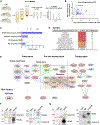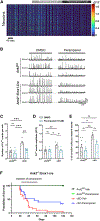Early developmental deletion of forebrain Ank2 causes seizure-related phenotypes by reshaping the synaptic proteome
- PMID: 37428632
- PMCID: PMC10566302
- DOI: 10.1016/j.celrep.2023.112784
Early developmental deletion of forebrain Ank2 causes seizure-related phenotypes by reshaping the synaptic proteome
Abstract
Rare genetic variants in ANK2, which encodes ankyrin-B, are associated with neurodevelopmental disorders (NDDs); however, their pathogenesis is poorly understood. We find that mice with prenatal deletion in cortical excitatory neurons and oligodendrocytes (Ank2-/-:Emx1-Cre), but not with adolescent deletion in forebrain excitatory neurons (Ank2-/-:CaMKIIα-Cre), display severe spontaneous seizures, increased mortality, hyperactivity, and social deficits. Calcium imaging of cortical slices from Ank2-/-:Emx1-Cre mice shows increased neuronal calcium event amplitude and frequency, along with network hyperexcitability and hypersynchrony. Quantitative proteomic analysis of cortical synaptic membranes reveals upregulation of dendritic spine plasticity-regulatory proteins and downregulation of intermediate filaments. Characterization of the ankyrin-B interactome identifies interactors associated with autism and epilepsy risk factors and synaptic proteins. The AMPA receptor antagonist, perampanel, restores cortical neuronal activity and partially rescues survival in Ank2-/-:Emx1-Cre mice. Our findings suggest that synaptic proteome alterations resulting from Ank2 deletion impair neuronal activity and synchrony, leading to NDDs-related behavioral impairments.
Keywords: CP: Developmental biology; CP: Neuroscience; LC-MS/MS; ankyrin; anti-epileptic drug; calcium imaging; postsynaptic interactome; proteomics; synchrony.
Copyright © 2023 The Authors. Published by Elsevier Inc. All rights reserved.
Conflict of interest statement
Declaration of interests The authors declare that they have no conflict of interest.
Figures





Similar articles
-
Roles of ANK2/ankyrin-B in neurodevelopmental disorders: Isoform functions and implications for autism spectrum disorder and epilepsy.Curr Opin Neurobiol. 2025 Feb;90:102938. doi: 10.1016/j.conb.2024.102938. Epub 2024 Dec 3. Curr Opin Neurobiol. 2025. PMID: 39631164 Review.
-
Self-limited familial focal epilepsy caused by ANK2 variants: A potentially under-recognized condition.Epilepsia Open. 2025 Apr;10(2):635-642. doi: 10.1002/epi4.70003. Epub 2025 Feb 17. Epilepsia Open. 2025. PMID: 39962910 Free PMC article.
-
Kv7/KCNQ potassium channels in cortical hyperexcitability and juvenile seizure-related death in Ank2-mutant mice.Nat Commun. 2023 Jun 15;14(1):3547. doi: 10.1038/s41467-023-39203-z. Nat Commun. 2023. PMID: 37321992 Free PMC article.
-
CDKL5 deficiency in forebrain glutamatergic neurons results in recurrent spontaneous seizures.Epilepsia. 2021 Feb;62(2):517-528. doi: 10.1111/epi.16805. Epub 2021 Jan 5. Epilepsia. 2021. PMID: 33400301
-
Mechanisms underlying the role of ankyrin-B in cardiac and neurological health and disease.Front Cardiovasc Med. 2022 Aug 4;9:964675. doi: 10.3389/fcvm.2022.964675. eCollection 2022. Front Cardiovasc Med. 2022. PMID: 35990955 Free PMC article. Review.
Cited by
-
Roles of ANK2/ankyrin-B in neurodevelopmental disorders: Isoform functions and implications for autism spectrum disorder and epilepsy.Curr Opin Neurobiol. 2025 Feb;90:102938. doi: 10.1016/j.conb.2024.102938. Epub 2024 Dec 3. Curr Opin Neurobiol. 2025. PMID: 39631164 Review.
-
Identification of proteome-wide and functional analysis of lysine crotonylation in multiple organs of the human fetus.Proteome Sci. 2025 Mar 13;23(1):2. doi: 10.1186/s12953-025-00240-9. Proteome Sci. 2025. PMID: 40082858 Free PMC article.
-
Cytoskeletal scaffolding of NaVs and KVs in neocortical pyramidal neurons: Implications for neuronal signaling and plasticity.Curr Opin Cell Biol. 2025 Jul 16;96:102570. doi: 10.1016/j.ceb.2025.102570. Online ahead of print. Curr Opin Cell Biol. 2025. PMID: 40674863 Free PMC article. Review.
-
Requirements for the neurodevelopmental disorder-associated gene ZNF292 in human cortical interneuron development and function.Cell Rep. 2025 May 27;44(5):115597. doi: 10.1016/j.celrep.2025.115597. Epub 2025 Apr 20. Cell Rep. 2025. PMID: 40257863 Free PMC article.
-
Self-limited familial focal epilepsy caused by ANK2 variants: A potentially under-recognized condition.Epilepsia Open. 2025 Apr;10(2):635-642. doi: 10.1002/epi4.70003. Epub 2025 Feb 17. Epilepsia Open. 2025. PMID: 39962910 Free PMC article.
References
-
- Satterstrom FK, Kosmicki JA, Wang J, Breen MS, De Rubeis S,An JY, Peng M, Collins R, Grove J, Klei L, et al. (2020). Large-Scale Exome Sequencing Study Implicates Both Developmental and Functional Changes in the Neurobiology of Autism. Cell 180, 568–584.e23. 10.1016/j.cell.2019.12.036. - DOI - PMC - PubMed
Publication types
MeSH terms
Substances
Grants and funding
LinkOut - more resources
Full Text Sources
Medical
Molecular Biology Databases
Miscellaneous

